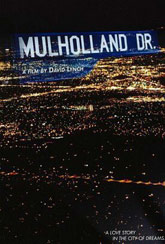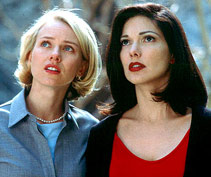| Mulholland Drive |
| |
 |
USA/France, 2001. Rated R. 146
minutes.
Cast: Naomi Watts, Laura Elena Harring,
Justin Theroux, Ann Miller, Dan Hedaya, Robert Forster, Mark Pellegrino,
Brent Briscoe, Billy Ray Cyrus, Michael J. Anderson, Angelo Badalamenti,
Maya Bond
Writer: David Lynch
Music: Angelo Badalamenti
Cinematographer: Peter Deming
Producers: Neal Edelstein, Joyce Eliason, Tony Krantz, Michael
Polaire, Alain Sarde, Mary Sweeney
Director: David Lynch
LINKS
|
 f
you are an intellectually oriented film lover, Mulholland Drive makes
a fascinating discussion topic.
f
you are an intellectually oriented film lover, Mulholland Drive makes
a fascinating discussion topic.
You can discuss the metaphor of the titular road, an ill-lit route that winds
its way along the crest of the Santa Monica mountains amid the abodes of the
wealthiest and most privileged Los Angelinos. In the film, it likely represents
the shadowy, twisted recesses of the mind, hidden and murky depths that exist
even (perhaps especially) among the privileged and wealthy. How characteristic
of writer/director David Lynch (Blue Velvet and TV's Twin Peaks),
always concerned with the dark underbelly of worlds of seeming normalcy. The
opening title, a shot of a Mulholland Drive street sign lit by flickering headlights,
is one of the most unsettling and memorable images in the film.
This can then lead to a discussion of how the movie is an impressionistic,
nightmarish foray into the psyche, with no dividing line between fantasy and
reality. Everything is an illusion, as a stage performer at the club Silencio
(or is it a theater?) declares over and over and over and over and over again.
AboutFilm.Com
The Big Picture
|
| Alison |
-
|
| Carlo |
C
|
| Claudia |
-
|
| Dana |
A
|
| Jeff |
A
|
| ratings explained |
You can then comment on the film's reversals, similar to those in Lynch's Lost
Highway. In Mulholland Drive, we meet the archetypal ingénue, Betty
(Australian Naomi Watts, also seen in Flirting and Dangerous
Beauty), who arrives in Hollywood with big dreams and an impossibly
wholesome persona that only Lynch could concoct. In her absent aunt's apartment,
Betty encounters a mysterious squatter with amnesia who calls herself Rita (Laura
Elena Harring, previously seen in various TV roles, including guest appearances
on Frasier). We know Rita from an opening sequence where she is the victim
of an attempted murder. Betty, being the archetypal ingénue, tries to help Rita.
On a parallel track, movie director Adam Kesher (Justin Theroux from American
Psycho and The Broken Hearts Club) resists mob attempts to cast
an actress named Camilla Rhodes as the lead in his movie. Interspersed are a
few apparently unrelated scenes involving people we don't know, scenes that
eventually will…remain unrelated.
After spending two hours seducing you with his characters and story, Lynch
just turns everything upside down. Characters change names and roles. Once the
archetypal ingénue, Watts becomes the archetypal jaded actress with shattered
dreams, who almost made it big but not quite. Watts, in an arresting performance,
handles the reversal adroitly. A scene where she (as Betty) gets a private audition
for some Hollywood bigwigs is particularly sublime.
Finally, you can analyze the non-linear plot. The story appears to be constructed
as a circle, ending up where it begins. It seems possible for one character
to move ahead in time but another to jump backwards. Is one character's actions
at the end of the movie responsible for events at the beginning? Cause becomes
effect and effect becomes cause.
You can say these things and more, and you might even be correct about them
all. No matter how much you investigate Mulholland Drive, though, the
bottom line is still that the movie is a garbled mess.
The setup is an alluring Lynchian mystery filled with quirky and enigmatic
characters--just like the Twin Peaks TV series. But like Twin Peaks,
the resolution, which resolves nothing, is a nonsensical letdown. The similarity
between Mulholland Drive and Twin Peaks may not be entirely coincidental,
as Mulholland Drive was originally conceived as a TV pilot, which does
not require a denouement. Only later, after the pilot was not picked up, was
Mulholland Drive filled out into a movie, which does require a denouement…in
theory.
Unlike, say, Memento, a film that challenges
you while still giving you a fair shot at solving the puzzle, Lynch doesn't
care if you solve his riddle. Mulholland Drive is more like a Rubick's
Cube. You can see its basic shape and all its component elements. You can even
picture what it's supposed to look like. Unless you already know the code, however,
it's virtually impossible to solve. In fact, it may not be actually possible
to solve Lynch's conundrum. An intriguing notion is that story is a circle,
but Lynch has not made a perfect circle; only certain elements of the story
work that way, and you're left with leftover pieces. Another possibility is
that most of the events in the first two-thirds of the movie occur in a dream
state, after the events in the last third. It's difficult, however, to make
everything add up in a way in which it all makes some kind of sense.
You might well draw the conclusion that Lynch has no interest in storytelling.
He's just fooling around with his pet moods and themes, resulting in the cinematic
equivalent of abstract art. Film school papers will probably be written on Mulholland
Drive for years, but the truth is that this is just another of those emperor-has-no-clothes
situations. Mulholland Drive is a brainteaser either for people much
smarter than me who can figure it all out, or for people who are easily amused
by striking imagery and oddball characters. Feel free to give it a shot, but
don't say you weren't warned.
Review
© October 2001 by AboutFilm.Com and the author.
Images © 2001 Universal Studios.


